Yes, baby dolphins drink milk like all other mammals’ children. However, milk feeding isn’t the same as humans. There are some similarities and dissimilarities between how dolphins and humans feed their babies.
This article will give you a closer look at how mother dolphins feed milk to their babies. So, dive into detail.
How Does a Dolphin Feed Milk to Its Baby?
Dolphins have a unique way of giving milk to their babies that makes up for how hard it is to nurse underwater. Instead of having exposed nipples, dolphins hide their mammary glands in slits in their abdomens. The mammary glands of the mother dolphin are the main source of milk. The mother dolphin squirts the thick milk into the mouth of the calf so that it can eat.
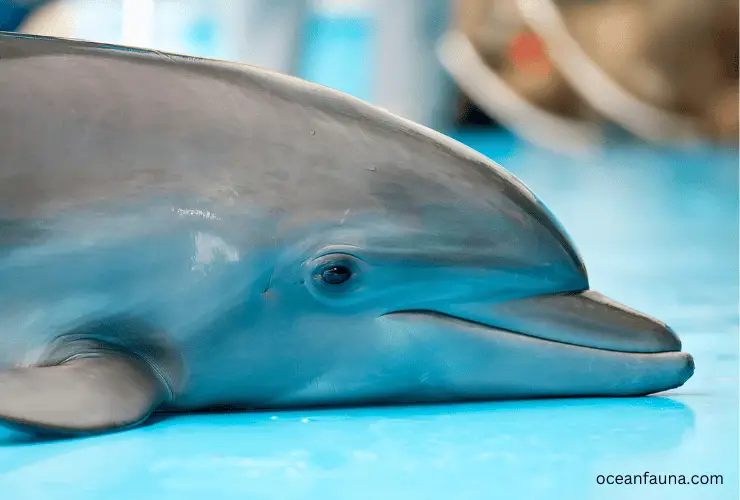
Since baby dolphins can’t catch fish yet, they need their mothers to feed them until they can learn this hunting skill. The fat content of dolphin milk is much higher than that of milk from other mammals. This helps dolphin babies grow quickly and stay healthy even though they don’t have access to food for the first few weeks of their lives.
After a calf learns how to hunt, it can rely on solid prey as its main source of food. It can still get food from its mother, occasionally in the form of milk or fish that has already been chewed.
How Long Do Baby Dolphins Drink Milk?
Baby dolphins typically drink their mother’s milk for 2 to 3 years. During this time, the baby dolphin is learning essential skills from its mother, such as hunting and communication.
Nursing also helps the baby dolphin build immunity to diseases and parasites found in the ocean. This protection extends beyond weaning, as a female dolphin will often nurse her young even after they have learned how to hunt.
For some dolphins, nursing can continue for up to ten years, ensuring that the youngster has enough energy and nutrition throughout its early life stages.
Where Is a Dolphin’s Mammary Gland Located?
A dolphin’s mammary gland is located inside the abdominal slits, which are situated around the flanks and lower torso. This placement of the mammary glands allows dolphins to nurse their young while protecting their sensitive organs from harm.
The mammary glands are covered by a thin layer of skin, which helps protect them from predators, harsh weather conditions, and other environmental factors.
Furthermore, because Dolphins have no nipples on the outside of their body as humans do, the concealed mammary glands help keep the nursing process inconspicuous from outsiders. As such, when it comes time for a mother dolphin to nurse her calf, she can do so in relative privacy.
Are Dolphins Good Mothers?
Yes, dolphins are perfect mothers. Female dolphins take great care of their young, often forming strong family bonds with them. They nurse their calves with milk for up to two-three years and nurture them by teaching them how to swim and hunt. Mothers will also form protective “playpens” by swimming in circles or making a line around their calf to protect it from predators.
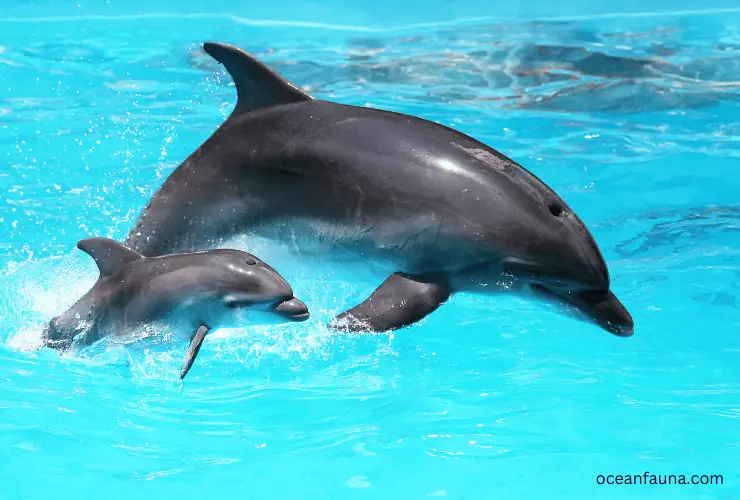
Additionally, they act as mentors to the calves, teaching social skills such as communication and play. Calves stay in the nursery pods for up to three years learning from their mother and other adult females before venturing off on their own.
Nursing has been observed occurring between many different members of the pod regardless of age, gender, or genetic relatedness, which adds an element of altruism that is unique among dolphin species. This demonstrates a level of empathy which is extremely important when it comes to motherhood. A mother dolphin provides nourishment for her calf and passes along values and skills so that it can survive alone in the wild.
Which Nutrients Do Baby Dolphins Have from Milk?
Baby dolphins receive a variety of essential nutrients from their mother’s milk. These include proteins, carbohydrates, lipids (fats), minerals, and vitamins necessary for a baby dolphin’s growth and development.
Proteins are essential for the growth and repairing cells and tissues. The mother’s milk provides these proteins in relatively large amounts to ensure the baby has enough to grow.
High levels of carbohydrates also provide energy and aid in growth, while lipids help support cell membrane integrity and aid in energy transport.
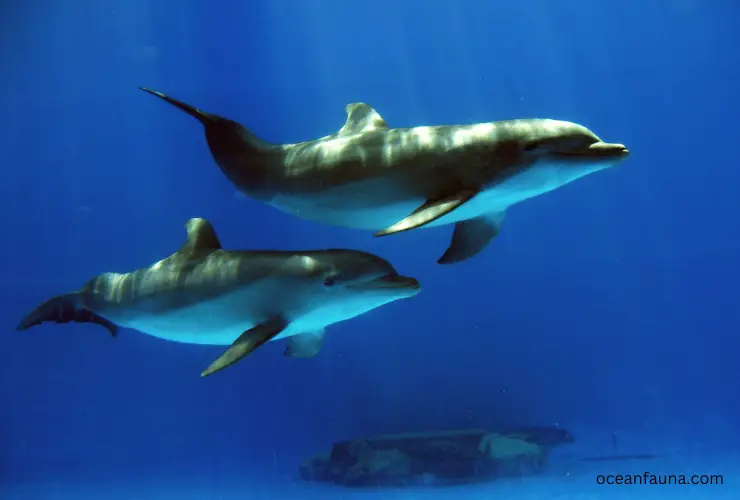
Minerals like calcium, phosphorus, magnesium, and sodium are also found in high amounts in the mother’s milk so that the baby dolphin can build strong bones and teeth.
Lastly, vitamin A is essential for vision development, vitamin B12 helps with red blood cell production, vitamin D is essential for bone health, and vitamin E helps protect against oxidative damage.
All of these nutrients are found together in the mother’s milk so that the baby dolphin can have all of them at once; this is why mother’s milk is considered one of nature’s most complete foods for young mammals.
What Do Baby Dolphins Eat?
Baby dolphins primarily only drink their mother’s milk for the first 2-3 years of life. During this time, they depend on the nutrients and antibodies the mother can provide to help them grow and develop.
After learning to swim and catch prey, baby dolphins consume small sea creatures such as fish, crustaceans, and squid. As they age, baby dolphins may also feed on seagrass or other plant material. Some dolphins may also look for food around fishing boats and docks if they can’t find enough from these natural sources.
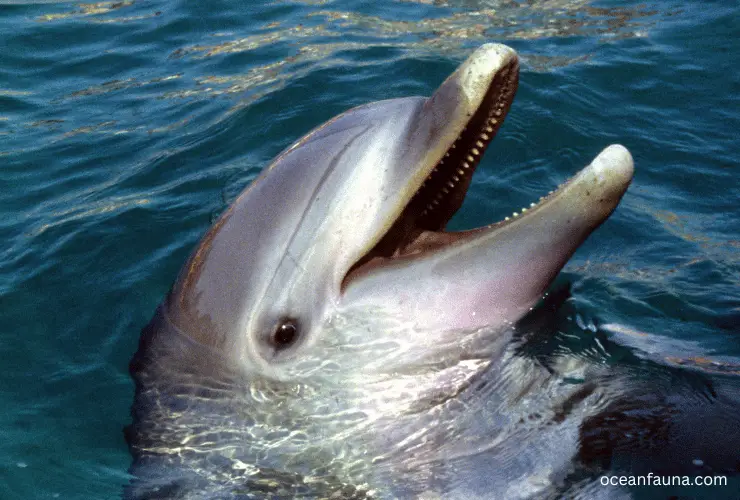
Once fully grown, dolphins can consume larger forms of prey, including octopuses, rays, turtles, and even sharks depending on the species.
Ultimately, the diet of each baby dolphin is determined by its environment and the availability of food sources in its area.
Similarities Between Baby Dolphins and Human Babies
Baby dolphins and human babies have many similarities.
- Both babies feed on their mother’s milk for their nutrition and development.
- Both new-borns are dependent on their caregivers for survival. Human babies need their parents to provide them with food, clothing, and basic necessities. Similarly, baby dolphins rely on their mothers to teach them the skills they will need to survive in the wild.
- Just like human babies, baby dolphins can bond emotionally with their parents and other pod members. They also learn from each other by watching how other dolphins interact and communicate with each other. This social structure helps baby dolphins develop essential life skills that are necessary for survival in the wild.
- Physical development is another similarity between human babies and baby dolphins. Like humans, dolphin calves start developing motor skills, such as swimming, even before they are born. After birth, they rely on these abilities to remain close to their mother as she teaches them more complex movements, such as hunting techniques or breaching behaviors.
- Like human infants who grow through stages of development and exploration before becoming adults, baby dolphins also go through similar stages of growth before reaching maturity at around seven years of age, when they become independent from their mothers.
Dissimilarities Between Baby Dolphins and Human Babies
Despite their many similarities, there are also some dissimilarities between human babies and baby dolphins.
- Human babies rely on their five senses of sight, hearing, taste, smell, and touch to explore the world around them as they learn and grow. Baby dolphins, however, have an additional sense known as echolocation, which allows them to navigate through the water and locate food sources. This sixth sense is not found in humans, making it a key difference between these two species.
- Unlike human babies, who stay close to their parents almost all of the time, baby dolphins often swim away from the pod for short periods to explore or practice hunting skills. Additionally, human babies can be taught to walk, but dolphins must learn how to swim.
- Human babies grow and mature much more slowly than baby dolphins. While humans reach adulthood between 18-21 years of age, Dolphins are fully grown at just seven years old and have the ability to reproduce.
Conclusion
So, now you have a compact knowledge of how baby dolphins drink milk. The similarities and dissimilarities are also discussed between baby dolphins and human babies.
Remember that baby dolphins entirely depend on their mother’s milk for the first 2-3 years. And after that, they start exploring more things to eat, like seagrass, octopuses, rays, sea turtles, and even sharks (in the case of a killer whale).

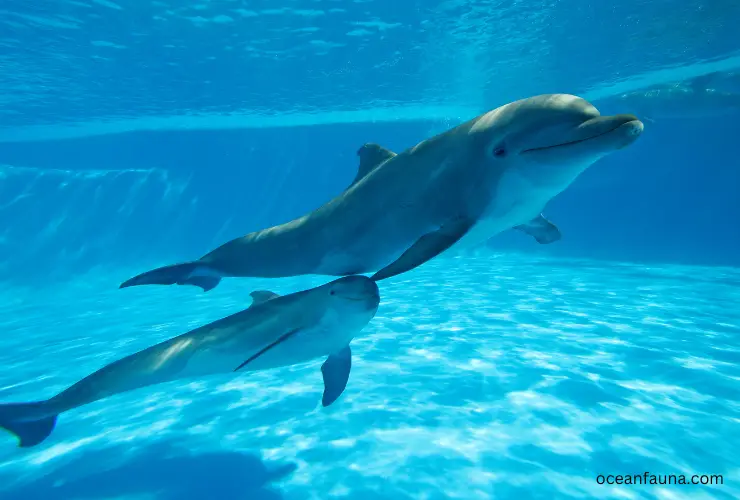
3 thoughts on “Do Baby Dolphins Drink Milk?”